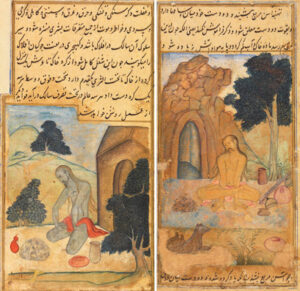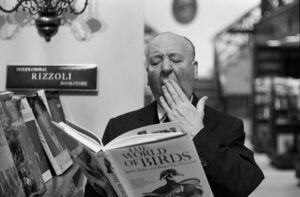- DHIRAJ SINGH
Research has shown that the attention span of a GOLDFISH is one second more than that of today’s humans which is at 8 seconds. If we look at the story of the story itself, we will realize that this process of diminishing attention spans started sometime in the 15th century. When Johannes Gutenberg began the first printing press. That in my view was the First Cause of this chain-reaction whereby technology began to disrupt the process and art of story-telling in a way that had never been seen before.
I don’t think poor Gutenberg—although a shrewd trader of religious artifacts and mementoes—would have known what a massive rupture he was about to cause in the history of mankind. In essence his invention of the MOVABLE PRESS was an analogue of the WINE-PRESS that was a much-used and familiar ‘machine’ of his time. The wine-press’ finished produce had been well-known way before Gutenberg’s time. But in a strange and unforeseen way both Gutenberg’s press and the wine-press became THE TWO THINGS that would turn man into a more self-aware and self-reflecting creature. The end result of the two presses were: mass-produced wine and mass-produced knowledge, something the world had never witnessed before.

Before GUTENBERG, books were meant to seen and not read. They were to be marvelled at as repositories of knowledge and the work of a group of copiers, calligraphers and painters. Story-telling, as a result, was an ORAL exercise where the story—mostly scriptural or courtly—was either told from memory or read out from hand-written books or even leaves, scrolls and stone. Because there were so few ‘sources’, stories had an AUTHORITY & BELIEVABILITY. Remember, knowledge in the middle ages was sacred and was therefore controlled by a few who had the power to limit its circulation, especially if competing interpretations of it were beginning to gain ground.
American Historian Elizabeth Eisenstein in her 1979 book ‘THE PRINTING PRESS AS AN AGENT OF CHANGE’ called the time following Gutenberg’s invention the “Unacknowledged Revolution”. This was because nowhere before had stories reached so far and wide and with such speed as they began to be after Gutenberg.
In fact, the 16th-century REFORMATION of the Catholic Church is also attributed by historians to the printing press. It was printing that made it possible for people like Martin Luther to print and openly circulate their ideas that questioned papal authority. To take from the creation story of the Bible, books were now playing the part of the serpent who created doubt in the minds of the first humans.

Within three years of Martin Luther’s first printing of his ‘95 Theses’ that questioned the buying of indulgences from the clergy, more than 300,000 copies of his book had been sold. In today’s terms, it had gone absolutely VIRAL, like the cat videos that slip into our feeds without asking.
The printing press has since fuelled many, many revolutions across continents and languages. They have unseated kings, wiped countries off the map and reimagined the past for us. Story-telling has been empowered so many times over that it is difficult to imagine a world without stories. WIRED UK magazine in a recent cover story observed: “Tech has weaponized good old-fashioned story-telling”. In effect this means that the STRATEGIC VIRTUES of story-telling have in today’s time been amplified so many times over that they now have the potential of being used as weapons of mass-distraction.
Today we are exposed to media that uses all the tropes of story-telling almost 24X7. It’s in our phones, in cabs, in classrooms and doctors’ waiting rooms, on highway hoardings and in airplanes! Advertisers are trying to catch our attention in all possible places, at all possible times.
In a 2008-study of US households, it was found out that they consumed a total of 3.6 ZETTABYTES of info annually. This was the equivalent of a 7-foot high stack of books covering the ENTIRE UNITED STATES OF AMERICA. The axis of this ginormous cycle of consumption still points to Gutenberg’s humble machine.

American media theorist and author Marshall McLuhan was prescient when he predicted the web almost 30 years ahead of its coming, especially when he gave us the word ‘SURFING’ to refer to rapid, irregular, and multidirectional movement through disparate texts. This is our reality today, except that we have added many more synonyms to that, such as ‘scrolling’, ‘swiping’ and ‘Googling’.
These remarkable changes in the way we are consuming stories today have also transformed the way stories are being told. The structure of the story itself has been undergoing reconstructive surgery. “The length of a film should be directly related to the endurance of the human bladder,” Alfred Hitchcock once said. Now the bladder has been replaced by ATTENTION SPAN.
The average length of a news story has been progressively decreasing since the late 1990s when newspapers began to go digital. Because in the digital world PERSPECTIVE CAN BE HYPERLINKED, or more simply: all questions needn’t be answered in one flow of words.
‘MOJO’ is a new field of journalism that’s opening up fast because it uses the methods of earlier broadcast or electronic journalism but is now contained in a mobile phone. Mojo has hugely reduced TV channels’ excessive dependence on staff and equipment.
Educational institutions are also creating intersections between these new forms of story-telling that create a more enhanced experience for both the teller & the listener/reader/viewer.
In a scenario where technology is with great speed empowering young people to share their opinions, ideas and stories it becomes important for educators to factor in this aspect in curriculums and academic programmes.
‘Knowledge is power’ is a fast-fading paradigm today. In the digital age, stories get published in minutes and can go viral in hours. Videos can do that in mere seconds. Yet stories don’t seem to be laden with the same authority that they once had.
Dhiraj Singh is a well-known journalist, writer, TV personality and artist who has shown his abstract paintings and X-Ray works in India and abroad. He is currently Director, School of Media & Journalism & The Idea Lab, MIT-World Peace University, Pune.